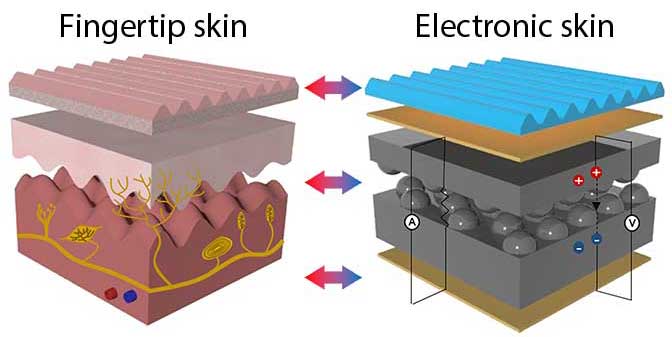Fingerprint-imitation leather recognizes pressure, temperature and even sound

South Korean scientists from the Ulsan State Institute of Science and Technology announced the creation of a new type of artificial skin that can “feel” not only pressure and temperature, but also microscopic changes in texture, and even respond to sound. The secret of the new multilayer material is the wavy surface structure, which largely repeats the surface of the fingertips of a person.
Recently, research has been rapidly moving towards the creation of various prototypes of artificial skin and the mechanisms for transmitting signals from it to the patient’s brain. True, until now, the resulting materials and devices could only recognize pressure and temperature ( and some - humidity) With the reproduction of the sensitivity of fingertips capable of recognizing irregularities in tenths of a millimeter, scientists are still experiencing problems.
Hyunhyub Ko, a chemical engineer at the institute, is optimistic about this. He and his colleagues created a thin and flexible multilayer material, capable of recognizing small irregularities. The surface of the material is ribbed, in the manner of fingertips, leaving unique prints. The bottom layer of the material is covered with microscopic spheres that help to recognize pressure and other deformation.
Pressing the material deforms its layers, which leads to the appearance of an electric current, the strength of which is proportional to the degree of deformation. The “artificial skin" feels the temperature in approximately the same way - when heated, the material expands and becomes softer, when it is cooled, it contracts and hardens.
An interesting side effect of the new material was its ability to recognize audio waves. When a team of engineers drew attention to the fact that their "electronic skin" reacts to sound, they conducted an experiment - they reproduced the word "skin" through the speakers, and recorded the electrical impulses coming from the "skin". Comparing the decrypted impulses with the recording made through the microphone of the smartphone, they were surprised to find that the “skin” recognized sound better than the smartphone.
Such developments will help in the creation of both highly sensitive robotic manipulators and new-generation prostheses. The next step of the engineers will be to develop a mechanism for transmitting the pulses collected from the “skin” into the brain. Teams of specialists working on similar problems are currently trying to develop both flexible electrodes and methods that use optogenetics.
Recently, American scientists talked about creating a flexible sensor that mimics the skin, and transmitting impulses in a form in which the brain can perceive directly, without the need for additional coding.
